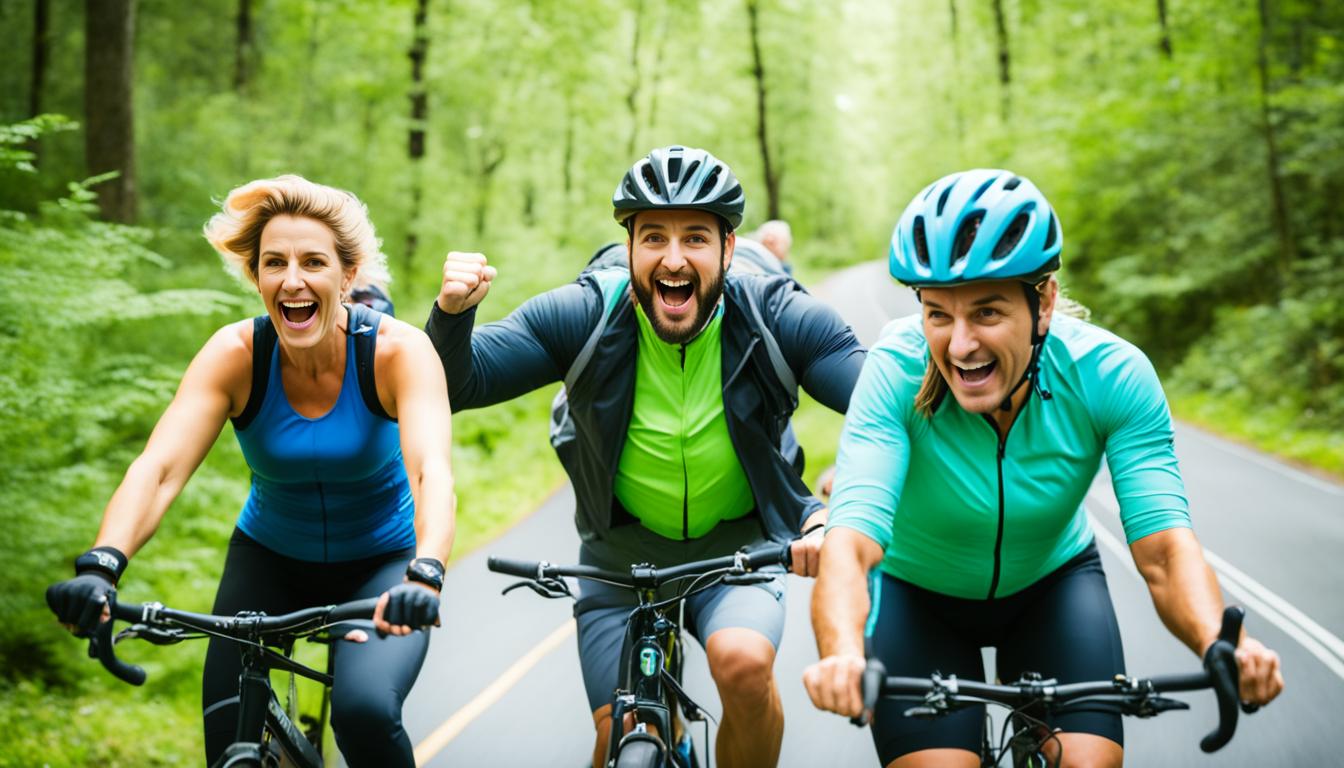Are you ready to hit the open road, feel the wind in your hair, and experience the exhilaration of biking? If you’re new to cycling, you may have some questions and concerns. How do you choose the right bike? What equipment do you need? How can you ensure a safe and enjoyable ride?
Don’t worry, we’ve got you covered! In this article, we’ll provide you with essential tips and expert advice to help you start your biking journey on the right foot. Whether you’re a complete beginner or looking to brush up on your skills, these biking tips will set you up for success.
Key Takeaways:
- Choose the right bike and equipment that suit your needs and ensure safety.
- Master basic bike handling skills to build confidence and control.
- Plan your routes carefully and start with beginner-friendly options.
- Focus on proper pedaling technique and body position for comfort and efficiency.
- Stay hydrated, fuel up, and obey traffic laws for a safe and enjoyable ride.
Choose the Right Bike and Equipment
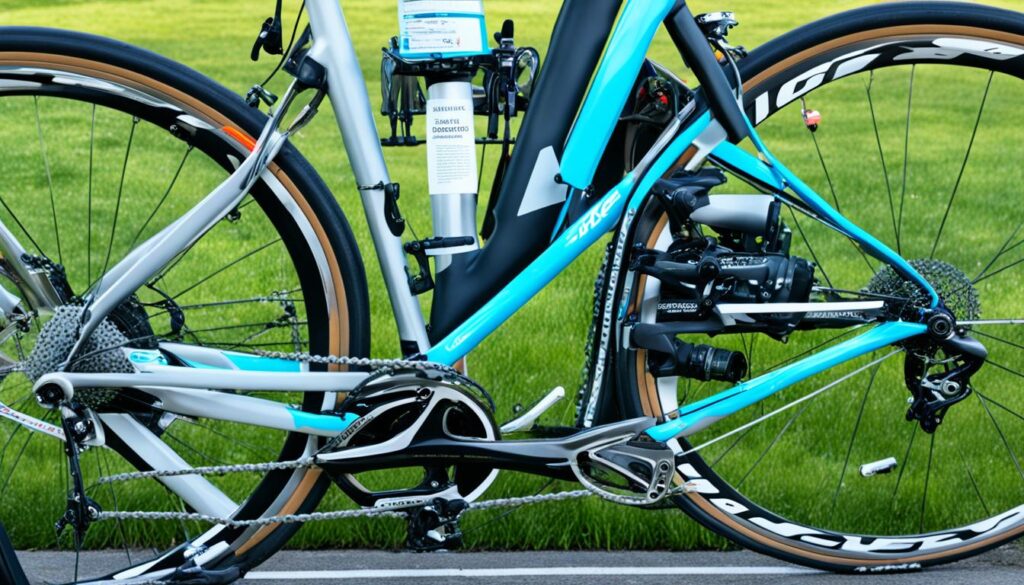
Before you embark on your cycling journey, it’s crucial to select the right bike and equipment. This beginner cycling guide will help you understand the essential cycling basics for beginners. So, let’s dive in and explore what you need to consider.
1. Find the Perfect Bike
Choosing a bike that suits your needs and fits you properly is the first step towards an enjoyable ride. Consider factors such as the bike’s purpose, terrain, and riding style to determine which type of bike is best for you. Whether it’s a road bike, mountain bike, or hybrid bike, make sure it aligns with your cycling goals.
2. Safety First: Wear a Helmet
As a beginner cyclist, safety should be your top priority. Protect your head by wearing a helmet every time you hit the road. A helmet is a crucial piece of equipment that can help prevent serious head injuries in case of accidents or falls.
3. Invest in Essential Gear
In addition to a helmet, consider investing in basic cycling gear for enhanced comfort and safety. Padded shorts can provide cushioning and reduce discomfort during long rides while cycling gloves offer better grip and reduce hand fatigue. Don’t forget to wear moisture-wicking clothing to stay cool and dry throughout your adventure.
4. Bike Accessories
Equip your bike with essential accessories like lights, reflectors, and a bike lock. Lights and reflectors will make you more visible to other road users, especially during low-light conditions. Investing in a sturdy bike lock will help protect your bike from theft.
“Choosing the right bike and equipment sets the foundation for a successful cycling journey. It ensures comfort, safety, and an enjoyable riding experience.”
By following these beginner cycling tips and selecting the appropriate bike and equipment, you’ll be well-prepared to begin your cycling adventure on the right pedal. Now that you have the basic knowledge, let’s move on to mastering essential bike handling skills in the next section.
Master Basic Bike Handling Skills
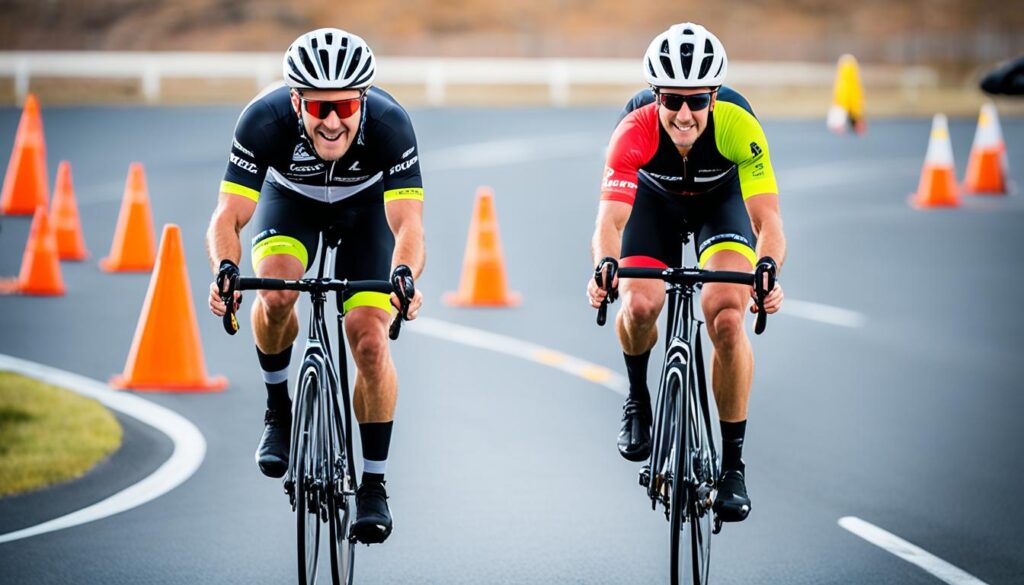
As a beginner, mastering basic bike handling skills is crucial for a safe and enjoyable ride. Balancing, steering, and braking are the foundations of bike control. Practice these skills in a controlled and safe environment to build confidence and improve your riding ability. Remember, Rome wasn’t built in a day, and neither were biking skills!
Start your journey with short rides and gradually increase the distance as you gain confidence in your abilities. Before hitting the road, it’s essential to familiarize yourself with proper hand signals and the rules of the road. Understanding these will ensure your safety and help you communicate with other road users. It’s like having your secret language on two wheels!
To help you get started, here’s a brief breakdown of the essential bike handling skills:
- Balancing: Achieve a stable and centered position while riding. Keep your weight evenly distributed, and practice maintaining balance at various speeds.
- Steering: Master the art of steering by smoothly and confidently maneuvering your bike around obstacles. Start with wider turns before progressing to tighter ones.
- Braking: Learn to modulate your brakes for controlled and responsive stopping. Practice braking on flat terrain and downhill slopes to gain confidence in your ability to stop safely.
Remember, becoming a skilled cyclist takes time and practice. Don’t be discouraged if you face challenges along the way. With dedication and persistence, you’ll soon be riding like a pro!
Essential Bike Handling Skills
| Bike Handling Skill | Description |
|---|---|
| Balancing | Achieve a stable and centered position while riding. Keep your weight evenly distributed, and practice maintaining balance at various speeds. |
| Steering | Master the art of steering by smoothly and confidently maneuvering your bike around obstacles. Start with wider turns before progressing to tighter ones. |
| Braking | Learn to modulate your brakes for controlled and responsive stopping. Practice braking on flat terrain and downhill slopes to gain confidence in your ability to stop safely. |
Practice these skills regularly and seek guidance from experienced cyclists or professional instructors if needed. With time and practice, you’ll be riding confidently and enjoying the freedom that biking brings.
Plan Your Routes and Start Slow
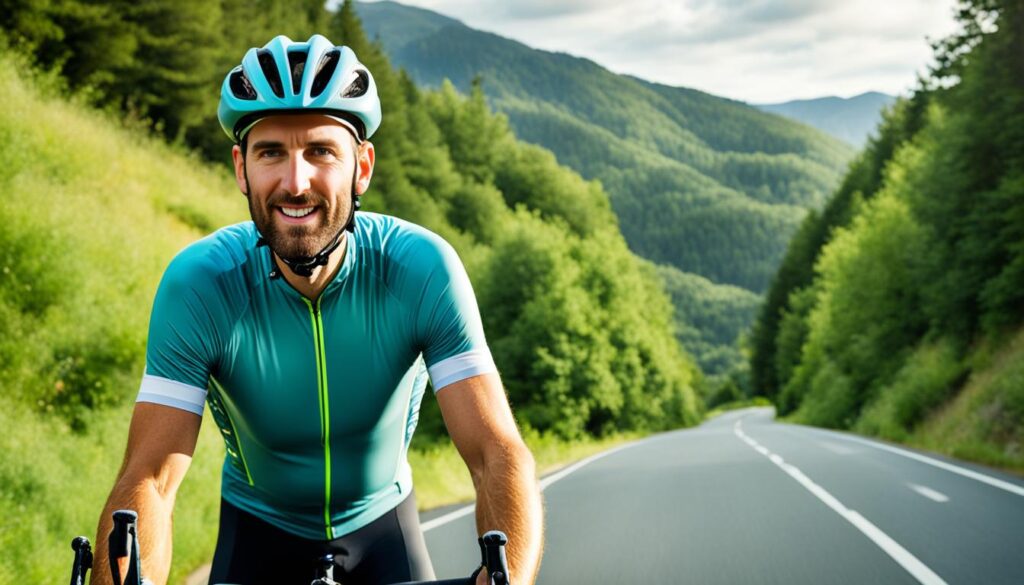
As a beginner cyclist, planning your routes is crucial for an enjoyable and safe riding experience. Take the time to carefully choose routes that are beginner-friendly and have minimal traffic. This will help you gain confidence and build stamina as you navigate through less challenging terrains.
Starting slow is key to avoiding overwhelming yourself and preventing injuries. Begin with shorter rides and gradually increase the difficulty level as you become more comfortable on your bike. Remember, it’s not a race! Take breaks and rest when needed to keep your rides enjoyable.
Find Beginner-Friendly Routes
Look for dedicated cycling paths or parks in your area where you can ride without worrying about heavy traffic. These routes are usually designed with beginner cyclists in mind, offering a safe and comfortable environment to practice your skills.
Utilize Cycling Apps and Websites
There are many cycling apps and websites available that can help you discover beginner-friendly routes in your area. These platforms often provide information about the distance, terrain, and level of traffic on each route, making it easier for you to plan your rides.
Explore Your Neighborhood
Don’t overlook the beauty of your neighborhood. Take the time to explore the streets and roads near your home. Familiarizing yourself with local roads will not only boost your confidence but also make it easier to incorporate cycling into your daily routine.
The joy of cycling lies in the journey, not just the destination. Take time to explore new routes and enjoy the scenery around you.
| Benefits of Planning Your Routes | Tips for Starting Slow |
|---|---|
|
|
By planning your routes carefully and starting slow, you’ll have a solid foundation for your cycling journey. Remember to enjoy the process, take breaks when needed, and explore the world around you on two wheels!
Focus on Your Pedaling Technique
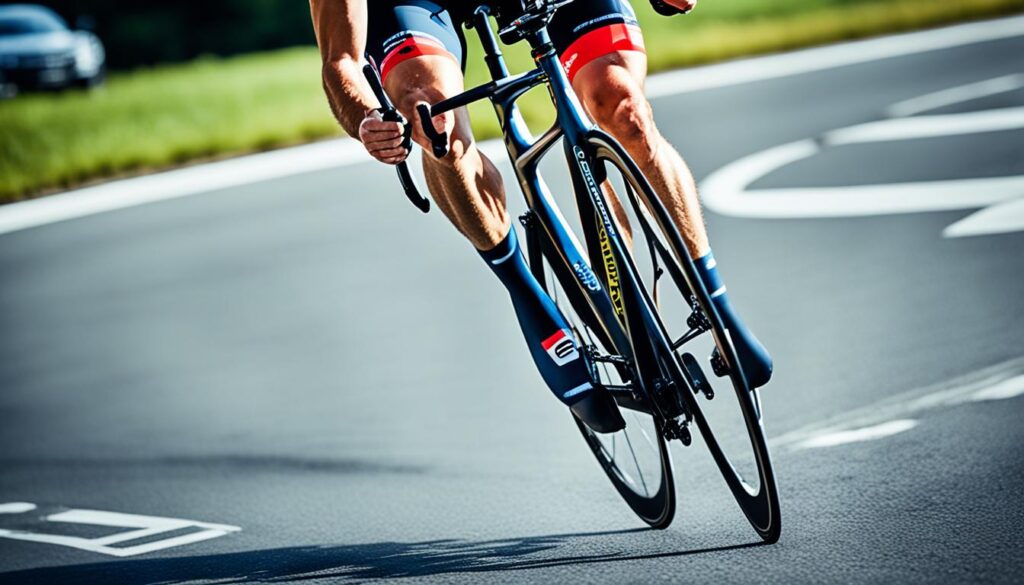
Proper pedaling technique is crucial for efficient and enjoyable cycling. Whether you’re a beginner or an experienced rider, mastering your pedaling technique can make a world of difference in your cycling performance. So, let’s dive into some tips to help you pedal like a pro!
Aim for a Smooth Circular Motion
When pedaling, strive for a smooth and fluid circular motion. Instead of stomping forcefully on the pedals, apply consistent pressure throughout the entire pedal stroke. This will help you maintain a steady rhythm and maximize your power output. Remember, it’s all about efficiency!
Shift Gears for Comfort and Efficiency
Don’t be afraid to shift gears to maintain a comfortable cadence. A cadence refers to the number of revolutions your pedals make in a minute. Aim for a cadence between 80 to 100 revolutions per minute (RPM) for an optimal balance between speed and endurance.
When climbing steep hills, shift to an easier gear to reduce the strain on your knees and muscles. Conversely, when descending or riding on flat terrain, shift to a harder gear to take advantage of your momentum and maintain your speed.
Practice Pedaling Uphill and Downhill
To improve your pedaling technique, it’s essential to practice both uphill and downhill scenarios. When climbing uphill, focus on maintaining a steady cadence while exerting controlled force on the pedals. This will help you conquer steep climbs with ease.
When descending, try to maintain a high cadence while keeping your pedaling smooth and controlled. This will help you maintain stability and control over your bike. So, embrace those hills and practice pedaling in various terrains to build your confidence and strength.
Don’t Forget About Your Knees
Your knees are crucial joints that can be prone to strain and injury if not properly taken care of while cycling. So, pay attention to your knee alignment and avoid excessive strain on this joint.
Make sure your knees track in line with your toes while pedaling. Avoid excessive inward or outward movement, as this can put unnecessary stress on your knee joints. If you experience any discomfort or pain in your knees, it’s advisable to consult a professional for guidance.
Incorporating specific strength exercises for your quadriceps and hamstrings can also help keep your knees strong and stable. Don’t neglect strength training as it can contribute to a better pedaling technique and overall cycling performance. Remember, a healthy body leads to happy and confident rides!
| Benefits of Proper Pedaling Technique | How to Achieve It |
|---|---|
| Improved energy efficiency | Aim for a smooth circular motion while pedaling |
| Reduced risk of knee strain or injury | Focus on maintaining proper knee alignment |
| Increased power output | Practice shifting gears for optimal cadence |
| Better endurance and performance | Incorporate uphill and downhill pedaling practice |
Remember, mastering your pedaling technique takes time and practice. Embrace the journey, be patient with yourself, and enjoy the process of becoming a better cyclist. Now, go out there and pedal your way to new adventures!
Pay Attention to Your Body Position
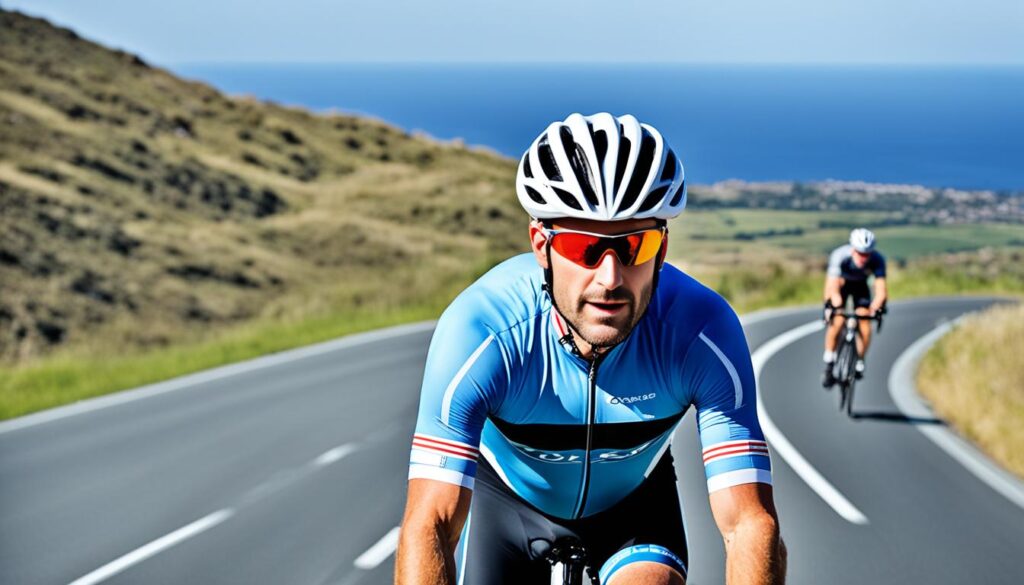
When it comes to cycling, your body position is more than just a matter of looking cool on the bike. It can make a world of difference in terms of comfort and efficiency during your rides. So, here are some tips to help you nail that perfect body position.
Maintain a Relaxed Grip and Balanced Posture
First things first, always remember to maintain a relaxed grip on the handlebars. You don’t want to be gripping them like your life depends on it. Instead, imagine holding a delicate wine glass – firm enough not to drop it, but gentle enough to avoid crushing it. This will help prevent unnecessary tension in your arms and shoulders, allowing you to enjoy a smoother ride.
Another important aspect of body position is maintaining a balanced posture. Keep your upper body relaxed and straight, with your shoulders level. Avoid slouching or excessively arching your back. By doing so, you distribute your weight evenly on the bike, enhancing your stability and reducing strain on your neck and lower back.
Engage Your Core Muscles for Stability
Engaging your core muscles is essential for maintaining stability on the bike. Think of your core as the powerhouse that connects your upper and lower body. It helps you generate power and keeps you steady while pedaling. So, make a conscious effort to activate your core muscles by drawing your belly button towards your spine. This simple action will improve your balance and prevent unnecessary swaying.
Regularly Adjust Your Position for Comfort
Cycling is all about finding that sweet spot where you feel both comfortable and efficient. Don’t be afraid to experiment with different positions throughout your ride. Shift your weight slightly forward or backward on the saddle, adjust the tilt of your handlebars, or change your hand positioning on the grips. These small adjustments can make a big difference in terms of alleviating discomfort and reducing the risk of injuries.
Remember, there’s no one-size-fits-all body position for cycling. It’s a personal journey of trial and error to find what works best for you. So, pay attention to your body’s signals and make adjustments accordingly.
Quote: “Finding the perfect body position while cycling is like solving a puzzle. It may take some time and experimentation, but once you unlock it, your rides will be transformed into a symphony of comfort and efficiency.” – Cycling Enthusiast
| Body Position Tips | Benefits |
|---|---|
| Maintain a relaxed grip on the handlebars | Reduced tension in arms and shoulders |
| Maintain a balanced posture | Even weight distribution, reduced strain on the neck and lower back |
| Engage core muscles for stability | Improved balance and power generation |
| Regularly adjust the position for comfort | Alleviated discomfort, reduced risk of injuries |
The table above summarizes the key body position tips and their benefits. Implementing these tips will help you achieve a more enjoyable and efficient cycling experience. So, go ahead, perfect your body position, and ride like a pro!
Stay Hydrated and Fuel Up Properly
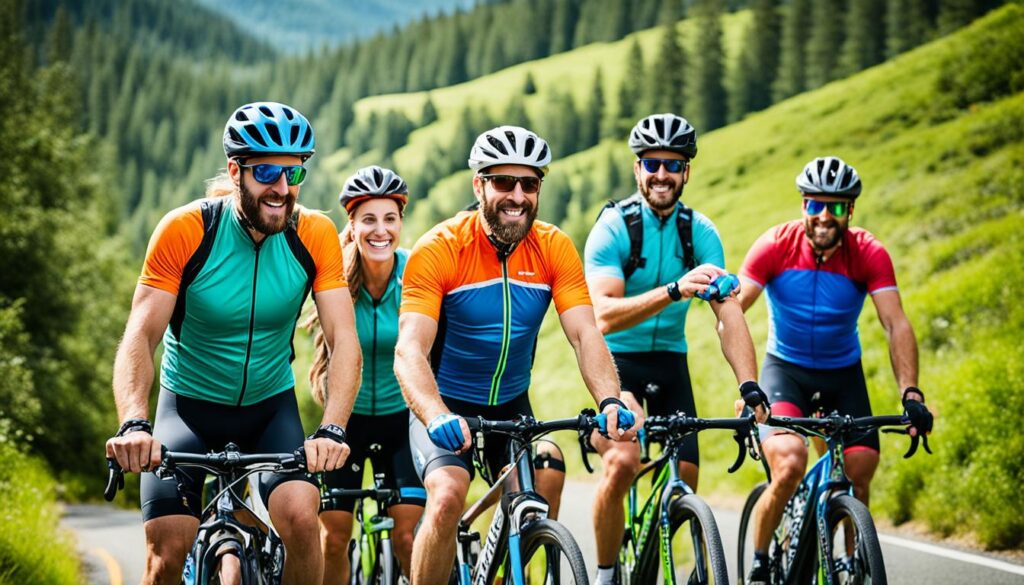
Hydration and nutrition are vital for a successful ride. As a beginner cyclist, it’s crucial to prioritize staying hydrated and fueling your body properly to ensure you have the energy and stamina to pedal through your cycling adventure. Here are some essential tips to keep in mind:
1. Always Carry Water
When hitting the road, don’t forget to bring a water bottle along. Hydration is key to maintaining your performance and preventing fatigue. Sip on water regularly throughout your ride to stay hydrated and keep your body functioning at its best.
2. Pack Snacks or Energy Bars
For longer rides, it’s important to fuel your body with the right nutrients. Pack snacks or energy bars that are easy to eat on the go and provide a good balance of carbohydrates, protein, and healthy fats. These will give you the sustained energy boost you need to power through your ride.
3. Listen to Your Body’s Signals
Pay attention to signals from your body during your ride. If you start feeling hungry or fatigued, it’s a sign that you need to refuel. Don’t ignore these signals and make sure to take breaks when needed. Trust your body and give it the nourishment it requires for optimal performance.
“Remember, even the best cyclist can’t pedal on an empty stomach!”
4. Plan Your Nutrition Strategy
Before you embark on a long ride, plan your nutrition strategy. Consider the duration and intensity of your ride and determine when and how often you need to refuel. This will ensure that you have a steady supply of energy throughout your cycling journey.
5. Recovery Nutrition
After your ride, focus on recovery nutrition. Your body needs to replenish its glycogen stores and repair muscle tissues. Opt for a post-ride snack or meal that combines carbohydrates and protein, such as a fruit and yogurt smoothie or a chicken wrap with whole-grain bread.
By paying attention to your hydration and nutrition, you’ll optimize your performance and enjoy a more enjoyable and energetic cycling experience.
Observe Traffic Laws and Be Visible
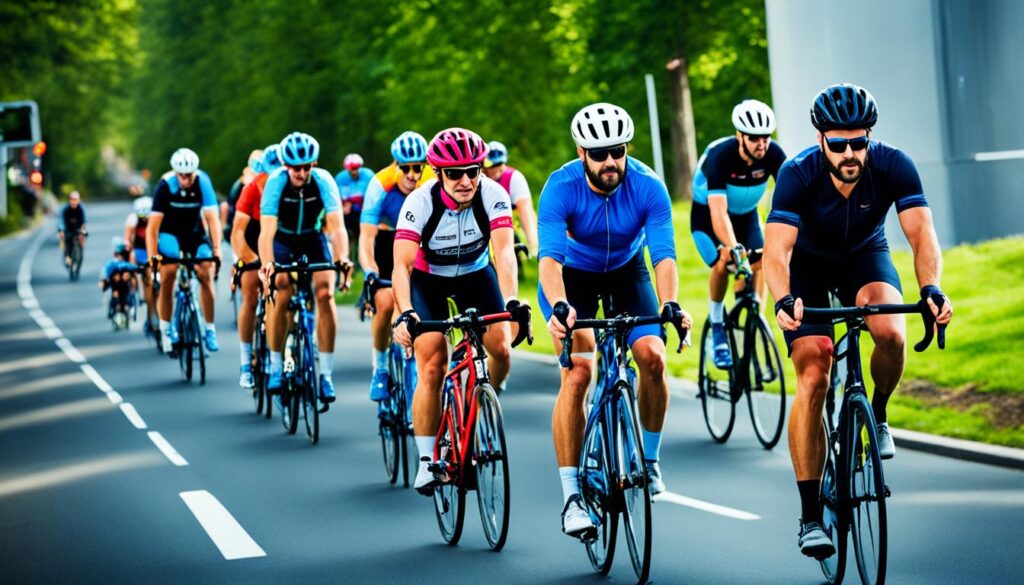
When it comes to cycling on the road, it’s not just about hopping on your bike and pedaling away. **Beginner bike riding tips** are important, and you need to know how to ride safely and responsibly. Here are some **cycling basics for beginners** that will help you navigate traffic and stay visible:
1. Obey Traffic Laws
To ensure your safety and the safety of others, always follow the traffic laws. This means stopping at traffic lights and stop signs, yielding to pedestrians, and using hand signals to indicate your intentions. It’s important to ride in the same direction as traffic and be aware of your surroundings.
2. Wear Bright Clothing
Being visible to motorists is crucial, especially in low-light conditions. **Cycling basics for beginners** involves wearing bright, reflective clothing that makes you stand out on the road. Opt for vivid colors like orange, yellow, or neon green. Consider investing in a reflective vest or stickers to further enhance your visibility.
3. Use Lights and Reflectors
Lighting up your bike is an essential step in **beginner bike riding tips**. Equip your bike with front and rear lights to make yourself visible to motorists from a distance. Choose lights with a strobe or flashing mode for added attention. Additionally, attach reflectors to your bike, pedals, and clothing to increase your visibility from all angles.
“Being visible on the road is key to safety. Remember, it’s not about blending in, but standing out!”
By observing traffic laws and making yourself visible to motorists, you’ll significantly reduce the risk of accidents or collisions. Always prioritize safety while enjoying your cycling journey!
Join a Cycling Community or Take a Class
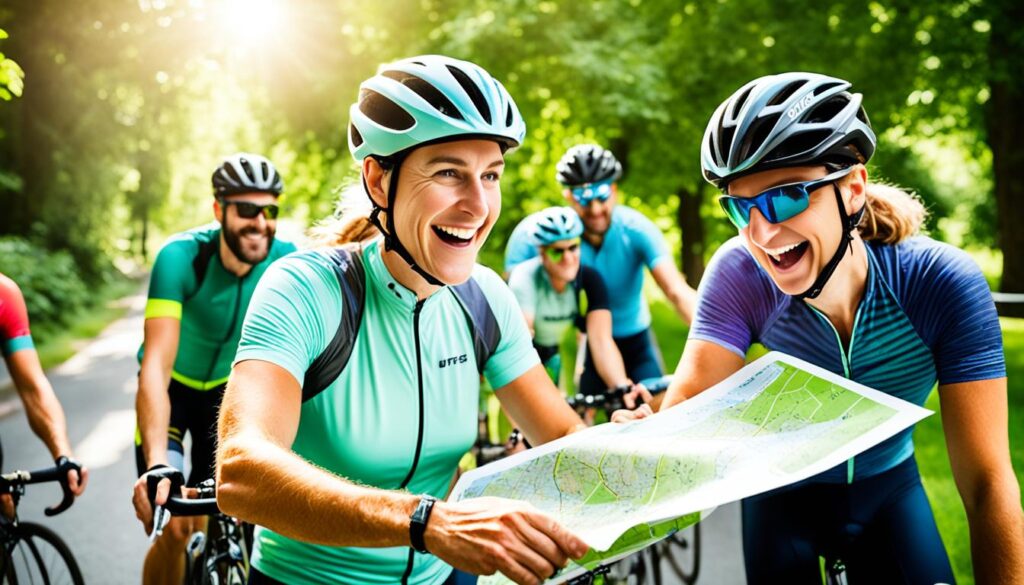
Looking to meet fellow cycling enthusiasts and deepen your knowledge of biking? Joining a cycling community or taking a beginner cycling class is a fantastic way to enhance your skills and expand your network. Not only will you have the opportunity to learn from experienced riders, but you’ll also gain confidence through group rides and discover valuable tips for beginner bike riding.
In a cycling community, you can connect with like-minded individuals who share your passion for riding. Whether you’re a beginner or have some experience under your belt, these communities welcome riders of all levels. You can exchange stories, get advice on beginner cycling tips, and explore new cycling routes together. The camaraderie and support from fellow cyclists can inspire and motivate you to keep pushing yourself.
If you prefer a more structured learning experience, consider taking a beginner cycling class. These classes are designed specifically for riders who are new to cycling or looking to improve their skills. Professional instructors will guide you through essential techniques, such as bike handling, proper form, and advanced maneuvers. They’ll also provide valuable insights on beginner cycling tips that will boost your confidence on the road.
Whether you choose to join a community or enroll in a class, remember that learning is a continuous process. Embrace every opportunity to expand your knowledge and refine your skills as a beginner cyclist. Soon enough, you’ll feel more comfortable on your bike and ready to take on new challenges.
| Benefits of Joining a Cycling Community or Taking a Class: |
|---|
| Access to experienced riders |
| Opportunity to learn and share beginner bike riding tips |
| Enhanced confidence through group rides |
| Discovering new routes |
| Networking and making friends with similar interests |
Testimonial from Sarah:
“Joining a cycling community was one of the best decisions I made as a beginner cyclist. Not only did I gain valuable riding tips from experienced riders, but I also made lifelong friends who share my love for biking. Together, we’ve conquered challenging routes and celebrated each other’s milestones. It’s a wonderful feeling to be part of such a supportive and inspiring community!”
Maintain Your Bike Regularly
Regular bike maintenance is crucial for a smooth and safe ride. As a beginner cyclist, it’s essential to take care of your bike to ensure it performs at its best. By learning some basic maintenance tasks, you can extend the life of your bike and avoid potential issues that may arise on your cycling adventures.
Check Tire Pressure
Conclusion
Starting your biking journey as a beginner can be an exhilarating and fulfilling experience. By following these essential biking tips for beginners, you can set yourself up for success and truly enjoy your cycling adventures. Remember, safety should always be your top priority throughout your biking endeavors.
Practice regularly to improve your skills and build your stamina. Utilize the knowledge gained from this beginner cycling guide to navigate different terrains and conquer any challenges that come your way. Whether you’re cycling for leisure, fitness, or commuting, these tips will help you make the most out of your time on two wheels.
Embrace the freedom and thrill that biking offers. With the right equipment, proper technique, and a dash of adventure, you can explore countless scenic routes and discover hidden gems in your surroundings. So strap on your helmet, hop on your bike, and embark on an unforgettable journey filled with exhilarating rides and newfound confidence.
